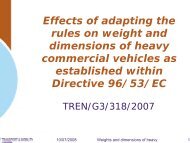Safe Distance between Vehicle - CEDR
Safe Distance between Vehicle - CEDR
Safe Distance between Vehicle - CEDR
You also want an ePaper? Increase the reach of your titles
YUMPU automatically turns print PDFs into web optimized ePapers that Google loves.
Page 2 / 9<br />
Authors: this report was drawn up by <strong>CEDR</strong>’s TG Road <strong>Safe</strong>ty<br />
Group leader: Günter Breyer<br />
With contributions from the following countries:<br />
Country<br />
Austria<br />
Belgium–Wallonia<br />
Name<br />
Günter Breyer, Eva M. Eichinger-Vill<br />
Daniel Heuchenne<br />
Belgium–Flanders Armand Rouffaert<br />
Denmark<br />
Estonia<br />
Finland<br />
France<br />
Germany<br />
Greece<br />
Iceland<br />
Ireland<br />
Italy<br />
Latvia<br />
Lithuania<br />
Luxembourg<br />
Netherlands<br />
Norway<br />
Poland<br />
Portugal<br />
Slovenia<br />
Sweden<br />
Switzerland<br />
United Kingdom<br />
Henrik Ludvigsen<br />
Reigo Ude<br />
Auli Forsberg<br />
Martine Broche, Nathalie Rolland, Pascal Chambon<br />
Stefan Matena<br />
Catherine Lerta, Anastasios Tsaglas<br />
Audur Thora Arnadottir<br />
Harry Cullen<br />
Sandro La Monica, Francesca La Torre, Giovanni Magaro,<br />
Alessandro Passafiume<br />
Ainars Morozs<br />
Gintautas Ruzgus<br />
Paul Mangen<br />
Herman Moning<br />
Richard Muskaug<br />
Robert Marszalek<br />
Paulo Marques<br />
Tomaz Pavcic<br />
Christer Rydmell<br />
Christoph Jahn<br />
David Gingell<br />
Approved and amended by: <strong>CEDR</strong>’s EXECUTIVE BOARD on 12 March 2009<br />
Addressed to: <strong>CEDR</strong>’s GOVERNING BOARD on 7 May 2009<br />
Edited and published by: <strong>CEDR</strong>’s Secretariat General on 23 April 2010<br />
<strong>Distance</strong> <strong>between</strong> vehicles
Page 3 / 9<br />
This report is:<br />
FOR INFORMATION PURPOSES ONLY<br />
1 General<br />
A review of the rules and practices concerning the safe distance <strong>between</strong> two vehicles on roads<br />
was performed in 2007 and 2008 by members of <strong>CEDR</strong>’s TG Road <strong>Safe</strong>ty.<br />
Member states were asked to answer the following questions:<br />
‣ Is there a regulation that governs the safe distance <strong>between</strong> vehicles in your country?<br />
‣ If so, what are the rules (e.g. leave at least 2 seconds following distance to the vehicle in<br />
front)?<br />
‣ Have you experienced any problems enforcing these rules?<br />
This paper sums up the answers received from <strong>CEDR</strong>’s member states.<br />
2 Regulations in <strong>CEDR</strong> member states<br />
Europe<br />
As far as safe distances in tunnels are concerned, the European directive 2004/54 on minimum<br />
safety requirements for tunnels on the TERN states the following:<br />
- Road users driving personal cars should under normal conditions maintain a minimum<br />
distance from the vehicle in front of them equivalent to the distance travelled by a vehicle<br />
in two seconds,<br />
- For heavy goods vehicles (HGVs), this distance should be doubled.<br />
Austria<br />
The section 18(1) of the Road Traffic Code (Straßenverkehrsordnung, StVO) states that the<br />
driver must adjust the distance <strong>between</strong> his/her car and the car in front, so that he/she can stop<br />
even if the car in front slows down suddenly.<br />
The paragraph 99 of this code deals with sanctions; it states that the safe distance must be<br />
greater than 0.4 seconds. Another paragraph states that two HGVs must keep a minimum<br />
distance of 50 meters (regardless of the speed at which they are travelling).<br />
The ‘2-second rule’ is taught at driving schools and is also painted on the pavement (either in<br />
the form of arrows or ‘21, 22’).<br />
Denmark<br />
The 2-second rule is applied. There are a few test sites where arrows have been painted on the<br />
road to persuade drivers to keep two arrows visible <strong>between</strong> the vehicles, which should<br />
correspond to the distance travelled by a vehicle in two seconds. The results of these tests have<br />
not yet been evaluated, even though some good results have been obtained in the UK using this<br />
method.<br />
<strong>Distance</strong> <strong>between</strong> vehicles
Page 4 / 9<br />
Estonia<br />
The Traffic Law requires drivers to keep a sufficient distance <strong>between</strong> their cars and the car in<br />
front in order to avoid a collision if the car in front brakes suddenly or stops. The 2-second rule is<br />
used as a rule of thumb.<br />
Finland<br />
The Traffic Law requires the driver to leave enough space to be able to stop without a collision if<br />
the vehicle in front brakes or stops. Although the ‘2-second rule’ is not explicitly mentioned in the<br />
Traffic Law, it is used as a rule of thumb. Gaps of less than 1 second for vehicles without air<br />
brakes are fined, when the speed is over 60 km/h; if the gap is less than 0,25 seconds the<br />
drivers licence may be suspended for at least 1 month.<br />
Gaps of less than 1,5 second (for vehicles with air brakes) are fined when the speed is over 60<br />
km/h, but if the gap is less than 0,35 second the drivers licence may be suspended for at least 1<br />
month.<br />
France<br />
The Road Code says that the driver must keep a safe distance <strong>between</strong> his/her vehicle and the<br />
vehicle in front in order to avoid collision if the car in front brakes or stops. The safe distance<br />
corresponds to the distance covered by the vehicles in at least 2 seconds. Outside urban areas,<br />
drivers following vehicles weighing more than 3.5 t or measuring 7 metres in length at the same<br />
speed must stay at least 50 meters behind the vehicle in front.<br />
The required safe distance can be raised for especially risky infrastructures.<br />
It is very difficult to enforce these minimum safe distances in France. Some devices help raise<br />
driver awareness about the safe distance, e.g. arrows or other road markings painted on the<br />
road. Automated enforcement systems are being tested for simple cases.<br />
Germany<br />
The Road Traffic Act requires drivers to leave a distance that will allow them to stop if the car in<br />
front brakes. In general, lorries must keep a distance of more than 50 m on motorways at<br />
speeds of above 50 km/h. For other vehicles, no exact rule has been defined in the Road Traffic<br />
Act. However, the 2-second rule is taught as a rule of the thumb.<br />
The catalogue of administrative fines (“Bußgeldkatalog”) determines different fines according to<br />
the actual speed and distance. Fines start at 25 € (speed less than 80 km/h and without<br />
endangering other road users) and can be up to 250 € plus 4 penalty points plus a 3 months<br />
suspension (speed higher than 130km/h and distance [m] less than 1/10 of current speed<br />
[km/h]).<br />
Iceland<br />
There is no regulation regarding the safe distance (gap) to be maintained <strong>between</strong> two vehicles.<br />
The relevant section of the Road Traffic Law reads as follows: ‘If vehicle B is driving behind<br />
vehicle A, the distance <strong>between</strong> the two vehicles shall be long enough to ensure that there is no<br />
risk of a rear-end crash if vehicle A should stop or slow down.’<br />
<strong>Distance</strong> <strong>between</strong> vehicles
Page 5 / 9<br />
Ireland<br />
The 2-second rule for ‘safe stopping distance’ is in the ‘Rules of the Road, however, this is not a<br />
legal requirement. A driver could be prosecuted for 'driving without due care and attention',<br />
which is a catch-all often used by the traffic police.<br />
Italy<br />
The Road Code states that all drivers must keep a safe distance <strong>between</strong> their vehicles and the<br />
vehicle in front, so that they can stop at the right time and avoid collision. Outside urban areas,<br />
when overtaking is forbidden for some categories of vehicles, <strong>between</strong> such vehicles a distance<br />
of at least 100 m is required. This rule does not apply for roads with 2 or more lanes in each<br />
direction. When winter maintenance is carried out by salt spreaders and snow ploughs, vehicles<br />
must proceed with extreme caution. <strong>Safe</strong> distance <strong>between</strong> such heavy duty vehicles must be at<br />
least 20 m. <strong>Vehicle</strong>s in the opposite direction, if necessary, should stop to allow these vehicles<br />
to perform their task.<br />
Anyone who violates these regulations is subject to fines ranging from 36 € to 148 €.<br />
If the same driver in the following 2 years is again found not respecting this rule, his/her driving<br />
licence is suspended from 1 to 3 months.<br />
Luxembourg<br />
The Road Code defines the minimum distances that must be maintained. No corresponding<br />
markings are painted on the roads. The 2-second rule is used as a rule of thumb.<br />
The Netherlands<br />
The 2-second rule is applied. The basis of this rule is as follows: 1 second reaction time and 1<br />
second braking time.<br />
In practice, few drivers apply this rule. Fines can be imposed if the distance <strong>between</strong> the two<br />
vehicles is less than 1 second.<br />
On a motorway, the capacity per lane is in theory about 1,800 vehicles per hour; in practice<br />
there are about 2,300 vehicles per hour per lane.<br />
Norway<br />
There is a regulation sanctioning the disregard of the safe distance to the vehicle in front:<br />
A: For vehicles weighing less than 3,500 kg:<br />
• A distance of <strong>between</strong> 0.00 seconds and 0.29 seconds leads to a suspension of the<br />
license for at least 6 months.<br />
• A distance of <strong>between</strong> 0.30 seconds and 0.50 seconds leads to a 3-6 month suspension.<br />
B: For vehicles weighing 3,500 kg and more:<br />
• A distance of <strong>between</strong> 0.00 seconds and 0.49 seconds leads to a suspension of the<br />
license for at least 6 months.<br />
• A distance of <strong>between</strong> 0.50 seconds and 1.00 seconds leads to a 3-6 month suspension.<br />
<strong>Distance</strong> <strong>between</strong> vehicles
Page 6 / 9<br />
Portugal<br />
Article 18 of the Road Legislation Code states that the driver of a moving vehicle should<br />
maintain sufficient distance <strong>between</strong> his/her vehicle and the vehicle in front to ensure that no<br />
accident occurs if the vehicle in front stops suddenly or reduces its speed.<br />
Switzerland<br />
By law, a driver must keep sufficient distance <strong>between</strong> his/her vehicle and the vehicle in front,<br />
taking into account that this vehicle could brake suddenly. In practice (i.e. in court), the 2-second<br />
rule or the half-speed rule (i.e. the distance in metres should be half of the actual speed in km/h)<br />
applies. The distance calculated by the half-speed rule is slightly less than the distance<br />
calculated using the 2-second rule and only applies in good weather conditions. Similar to other<br />
countries, Switzerland has problems with enforcement.<br />
Sweden<br />
The police impose a fine when the safe distance is less than 1 second. If the safe distance is<br />
less than 0.5 seconds, the driver’s driving license is revoked. Enforcement problems do exist.<br />
UK<br />
There is no specific regulation for close following. However, the Highway Code Rules for safe<br />
stopping distances contains the 2-second rule. Many of the Highway Code Rules are legal<br />
requirements; the safe stopping distance is not one of them. However, if a driver is caught<br />
disregarding such a Highway Code Rule that could be considered a hazard, a driver could be<br />
prosecuted for 'driving without due care and attention', which is a catch-all often used by the<br />
traffic police.<br />
<strong>Distance</strong> <strong>between</strong> vehicles
Page 7 / 9<br />
The regulations described above are summarized in the following table.<br />
Country<br />
Austria<br />
Denmark<br />
Estonia<br />
Finland<br />
France<br />
Germany<br />
Iceland<br />
Ireland<br />
Italy<br />
Luxembourg<br />
Netherlands<br />
Norway<br />
Portugal<br />
Sweden<br />
Existing law or regulation<br />
Yes (Road Traffic Code) :<br />
- Adjust distance to be able to stop<br />
if necessary<br />
- Sanction based on minimum time<br />
or distance<br />
Yes (Traffic Law) :<br />
- Keep sufficient distance to avoid<br />
collision<br />
Yes<br />
Traffic Law :<br />
- Adjust distance to be able to stop<br />
if necessary<br />
- Sanction according to the<br />
minimum time or distance<br />
Yes (Road Code) :<br />
- Sufficient distance to avoid<br />
collision if car in front brakes or<br />
stops<br />
Yes (§4 Road Traffic Act)<br />
- Drivers must be able to stop in<br />
time if the car in front brakes<br />
- 50 m for lorries if speed > 50<br />
km/h<br />
Yes (Road Traffic Law)<br />
- Sufficient distance to avoid<br />
collision<br />
No<br />
- The law stipulates ‘driving with<br />
care and attention’<br />
Yes: Road Code Art. 149<br />
- Adjust distance to be able to stop<br />
if necessary and avoid collision<br />
Yes: Road Code<br />
- Sufficient distance to avoid<br />
collision<br />
Yes<br />
Fine is imposed if distance < 1s<br />
Yes<br />
Yes (Road Legislation Code)<br />
- Sufficient distance to avoid an<br />
accident if the car in front stops or<br />
reduces speed<br />
Yes<br />
Fine is imposed if distance < 1s<br />
Yes (law)<br />
Switzerland - Sufficient distance in case car in<br />
front brakes<br />
No<br />
UK<br />
But ‘driving with care and attention’ No<br />
is mentioned in the law<br />
The distance of the ‘half-speed rule’ corresponds to 1.8 seconds.<br />
Threshold for enforcement<br />
set by law or regulation<br />
Yes<br />
- Gap < 0.4 s<br />
- <strong>Distance</strong> < 50 m for lorries<br />
The 2-second rule is used<br />
by police.<br />
No<br />
Yes<br />
- Gap < 1 s; distance<br />
depends on the speed<br />
- Gap < 1.5 s for lorries;<br />
distance depends on the<br />
speed<br />
Yes<br />
- Gap < 2 s<br />
- <strong>Distance</strong> < 50 m for lorries<br />
> 3.5 t or < 7 m, in<br />
interurban areas at the same<br />
speed<br />
Yes<br />
Quarter-speed rule<br />
Fines depend on actual<br />
speed and distance and are<br />
imposed if drivers break the<br />
quarter-speed rule.<br />
No<br />
No<br />
Yes<br />
< 100 m <strong>between</strong> lorries<br />
outside urban areas<br />
< 100 m (interurban) and 50<br />
m (urban) behind dangerous<br />
goods<br />
Yes<br />
Time < 1s<br />
- Gap < 0.3 s<br />
(if vehicle < 3.5 t)<br />
- Gap < 0.5 s<br />
(if vehicle > 3.5 t)<br />
No<br />
If
Page 8 / 9<br />
3 Conclusions<br />
In most countries in Europe, the general rule is that each driver must keep sufficient distance<br />
<strong>between</strong> his/her vehicle and the vehicle in front in order to avoid an accident if the car in front<br />
stops suddenly or reduces speed.<br />
This rule does not always come with specific distances that must be observed, such as the<br />
required minimum distance or time <strong>between</strong> the vehicles. In those cases where minimum<br />
distances or times are provided, the figures vary greatly from country to country. The 2-second<br />
rule or the half-distance rule can be applied. Different, specific rules can be applied to heavy<br />
goods vehicles. The 2-second rule is often used as a rule of the thumb and taught at driving<br />
schools.<br />
Some devices (e.g. road markings) are used to help drivers obey the rule.<br />
Still, most countries encounter problems with enforcement.<br />
<strong>Distance</strong> <strong>between</strong> vehicles
Ref: <strong>CEDR</strong> report 2009/10.1<br />
TGRoad<strong>Safe</strong>ty / <strong>Distance</strong><strong>between</strong><strong>Vehicle</strong>sReport<br />
La Grande Arche, Sud 19 e<br />
FR – 92055 PARIS – LA DEFENSE<br />
Tel.: + 33 (0) 1 40 81 36 87 Fax: + 33 (0) 1 40 81 99 16










